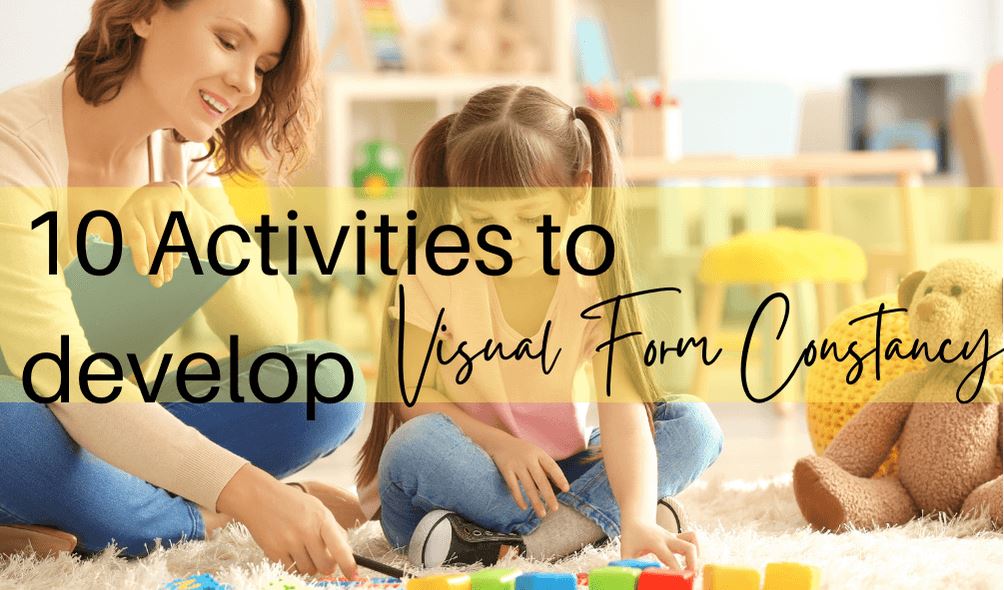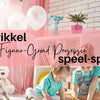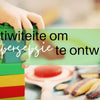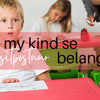10 Activities to develop Visual Form Constancy

What is Visual Form Constancy?
Visual form constancy is the ability to recognize that a shape or object remains the same despite changes in size, position, direction, orientation and distance, e.g. an object is still the same whether it is seen from the top, side or underneath. Visual form constancy is also the ability to mentally manipulate an object into different positions just by looking at it.
Visual form perception and early development.

Children who struggle with this skill might have trouble reading handwritten words that look different than their printed counterparts.
They may find it difficult to recognize shapes, numbers and letters, when they are presented in a different context (for example when they see them in the playground instead of in the classroom) or when the color, size or font changes.
Why is visual form perception important?
Visual form constancy enable children to interpret the environment accurately, regardless of changes in presentation.
Visual form constancy are important for many every day skills such as reading, writing, completing puzzles, dressing as well as many other skills.

What can we do ?
1.Place some household items on a tray and ask the child to pick out specific shapes from those items.
2.Identify different objects in a room, that are the same shape, e.g. touch everything that is square in the room.
3.Instruct your child to jump, climb or sit on objects with different shapes in the room, e.g. Simon says climb on the block or sit on the ball.
4.Chalk shape jumping game - Use chalk to draw different shapes on the ground and let the children jump from the one side to the other side by choosing a specific shape that the child may only jump on to get to the other side.
5. Draw different shapes with chalk on the floor or make the outlines of the shapes with masking tape. Let the child walk on the outlines of the shape. Name the shape repeatedly as your child does this activity.
6.Obstacle courses using the same shape in different sizes or orientation.
7. Sorting objects by shape, size, texture, colour, category or orientation (horizontal, vertical, tilted at an angle). Teach same/different, differentiate between objects, and shapes with obvious differences, gradually introducing smaller differences.
8. Arts and craft activities, Cut out the same shape, but in different sizes and use for collage. To make it more adventures let the children find leaves with the same shape outside and make a collage with it. Using different media (pipe cleaners, play dough) to form the same shapes as on a piece of paper. Order objects with the same shape but different sizes from the smallest to the biggest.
9.Show young children an object (truck, brick, teddy) and get them to guess what it is when they only see the front, back, side or bottom of the object. Match 3D objects with 2D shapes or objects on card.
10.Worksheets and activities
- Draw a line from each shape on the left to the matching shape on the right side of the worksheet.
- Matching directions; color all the arrows that point to the right blue and the arrows that point to the left side red.
- Circle all the same letters on the worksheet for example; circle all the letter D’s on the worksheet.
- Write the same letter or word in many different styles, colours, and size.



Additional Tips:
Use appropriate language to describe orientation and position of an object or objects. Use language to describe the differences in objects and shapes for example; the small block or the eraser is a square. Verbalise and talk through properties and orientation of objects to help the child form a concept. Demonstrate how horizontally presented material looks when presented vertically.
Feel free to browse our website for more activities, ideas and resources or follow us on Teachers Pay Teachers, Facebook, Instagram and Pinterest.
OUR PRODUCTS

SPATIAL PERCEPTION RESOURCE BUNDLE, R250 $17,50
Occupational Therapy resource bundle for spatial perception.







